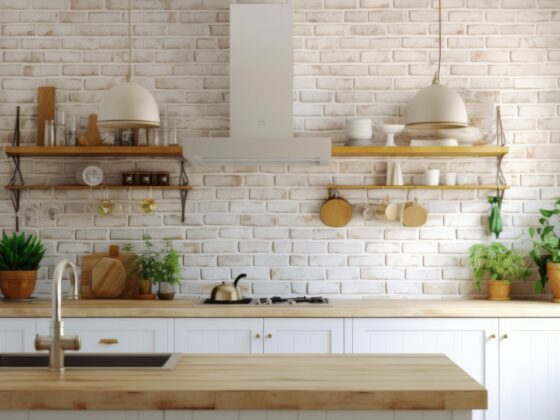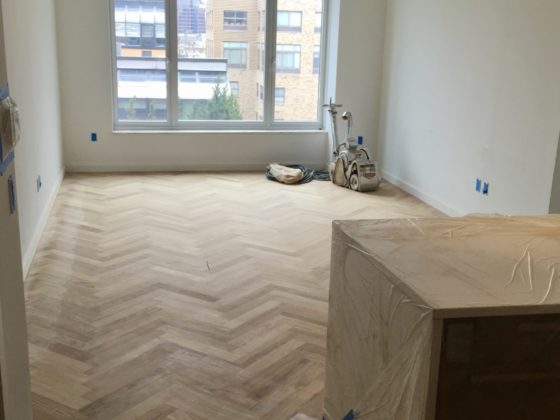Table of Contents Show
There is nothing quite like a renovation to breathe new life into your home or update a new one. But they don’t come cheap, and New Yorkers have a record of splashing out far more than their Midwestern counterparts. And why not? A gut renovation ensures less maintenance and increases the home’s value. The first question to tackle is coming up with a rough idea of how much it will cost. Once arrived at, the next one will be, “How long will it take?”
Bolster, an NYC-based design-build firm has devised a way to remove some guesswork. After analyzing two years of data on completed projects, they made some interesting findings. For starters, there is always a jump in interest from homeowners looking to start a renovation in the summer in the first quarter of each year. However, the data also showed a lot of variation in the actual start and finish dates—the most significant variable in the design process. Depending on the project’s scope, it can take one month to over a year before the work starts.
New York City Renovation SchedulesNew York City Renovation Schedules
| Property Type | Design Schedule | Build Schedule | Total Schedule |
|---|---|---|---|
| Minimum | 1 Month | 5 Months | 6 Months |
| Average | 6 Months | 7 Months | 13 Months |
| Maximum | 14 Months | 12 Months | 26 Months |
The Design Phase:The Design Phase:
When putting your design team together, the quality of the people chosen will naturally affect the project’s speed. Unfortunately, many homeowners make the mistake of trusting their expeditor to keep everything on track. However, Bolster’s data found that what has a more significant impact is choosing an experienced architect. Hire someone who has experience with your type of property. They also understand how to work with government agencies and building management whose approvals will be needed.
Property Type:Property Type:
The next thing that impacts the length of your project is the type of property you live in.
- Co-ops: Expect tough negotiations and delays if your building is a co-op. The board can be a nuisance with uncertainties, especially if they meet infrequently and there’s no precedent for the type of renovation you’re doing. However, if the building has an alteration agreement, this can help speed things up.
- Condos: Condos face the same difficulties as co-ops, though not as extensively. Condo boards tend to be more relaxed than co-op boards.
- Landmark Properties: If you live in a landmarked building, you could have a big headache. The project will be subject to a public hearing, which can be frustratingly open-ended and depends on the attitude and knowledge of the review officer.
- Brownstones: By far and away, brownstones present the most minor delays in the design phase. There’s no co-op board or building architect you need to get around, but they sometimes present logistical challenges. For instance, the lack of an elevator makes transporting materials more troublesome.
Renovation Schedules by Property TypeRenovation Schedules by Property Type
| Property Type | Design Schedule | Build Schedule | Total Schedule |
|---|---|---|---|
| Brownstone | 5 Months | 8 Months | 13 Months |
| Co-op | 7 Months | 6 Months | 13 Months |
| Condo | 7 Months | 6 Months | 13 Months |
| Landmark | 6 Months | 6 Months | 12 Months |
The Scope of the Work:The Scope of the Work:
Naturally, the scope and type of renovation will dramatically affect its timeline. Any HVAC, plumbing, or electrical changes will mean more regulatory challenges and delays. To avoid tampering with them if possible.
- Rooftops: Any changes to the roof tend to add the most extended timeframe to a renovation, 20 months on average, because they involve a degree of danger and are subject to weather changes that require better planning and construction.
- Apartment Combinations: Specialists must ensure they don’t encounter structural problems during an apartment combination. Neighbor complaints about safety and cleanliness can also cause delays.
- Gut Renovations: Generally, gut renovations take less time than rooftop or combination changes. This means delays as revisions are made. However, they also mean greater scrutiny by the Department of Buildings and building management.
Renovation Schedules by Project TypeRenovation Schedules by Project Type
| Property Type | Design Schedule | Build Schedule | Total Schedule |
|---|---|---|---|
| Rooftops | 13 Months | 7 Months | 20 Months |
| Combinations | 8 Months | 7 Months | 15 Months |
| Gut | 5 Months | 7 Months | 12 Months |
SummarySummary
The more you’re spending, the longer you expect it to take. Your timescale is very likely to go overboard for renovations like your budget. Some minor changes only take about six months. More extensive modifications, such as a gut renovation, can take over a year. While even more extensive changes can take as many as two years. Apply the same due diligence with design and planning as you do to your budget, and you should arrive at a reasonable estimate.
Renovating a Home in NYC: A Symphony of Time and PrecisionRenovating a Home in NYC: A Symphony of Time and Precision
Renovating a home in New York City is an endeavor as iconic and intricate as the city itself. It’s a ballet of builders, architects, and bureaucratic red tape set against towering skyscrapers and historic brownstones. From the cobblestone streets of Greenwich Village to the gleaming high-rises of Midtown Manhattan, homeowners seeking to transform their living spaces must navigate a labyrinth of regulations, timelines, and neighborhood dynamics.
Understanding the TimelineUnderstanding the Timeline
The timeline of a renovation project in NYC is a delicate dance of planning, execution, and adaptation. While no two projects are alike, a typical renovation journey follows a roadmap that can span several months or even years, depending on the scope and scale of the work involved.
Preliminary Planning (1-2 months)Preliminary Planning (1-2 months)
Every renovation journey begins with a vision – a dream of transforming a space into something new and exciting. During preliminary planning, homeowners define their project goals, establish a budget, and research potential contractors, architects, and other professionals. This is the time to dream big, brainstorm ideas, and gather inspiration from design magazines, websites, and social media platforms. Whether it’s a sleek modern kitchen or a cozy vintage-inspired living room, homeowners should take the time to articulate their vision and identify their must-haves and deal-breakers.
Pre-Construction Phase (1-2 months)Pre-Construction Phase (1-2 months)
With a clear vision, homeowners engage with architects to translate their ideas into reality. The architect becomes the maestro of the renovation symphony, crafting detailed plans and drawings that serve as the blueprint for the project. For homeowners residing in condos or co-ops, this phase also involves securing necessary approvals from the building’s board of directors and executing alteration agreements that outline the terms and conditions for renovating within the building. These agreements often include provisions regarding noise, construction hours, insurance requirements, and indemnification clauses.
Obtaining Permits and Approvals (varies)Obtaining Permits and Approvals (varies)
In New York City, many renovation projects require permits from the Department of Buildings (DOB) to ensure compliance with building codes and zoning regulations. Obtaining permits can be arduous and time-consuming, as applications are subjected to rigorous review by DOB inspectors and plan examiners. Depending on the scope of work, homeowners may need to file applications for construction permits, plumbing permits, electrical permits, and other approvals before commencing renovations. Working with experienced expeditors can streamline this process by navigating the intricacies of DOB filings and ensuring timely approvals.
Construction Phase (varies)Construction Phase (varies)
With permits in hand and plans approved, the real work begins. The construction phase of a renovation project is a flurry of activity as contractors, plumbers, electricians, and other tradespeople work tirelessly to bring the homeowner’s vision to life. From demolition and site preparation to structural work and finishing touches, each step of the construction process requires precision, skill, and attention to detail. It’s a collaborative effort that requires effective communication, meticulous planning, and adaptability when facing unforeseen challenges.
Post-Construction Phase (1-2 months)Post-Construction Phase (1-2 months)
As the dust settles and the paint dries, the post-construction phase of a renovation project begins. This is the time for final inspections, walkthroughs, and adjustments to ensure that every detail meets the homeowner’s expectations. This phase is critical for ensuring the long-term success and satisfaction of the project, whether it’s addressing punch list items, resolving warranty issues, or obtaining final sign-offs and approvals from relevant authorities.
The Role of Architects and ExpeditorsThe Role of Architects and Expeditors
In New York City renovations, architects and expeditors are the unsung heroes behind the scenes. Architects bring creativity, expertise, and technical know-how to the design process, transforming abstract ideas into tangible blueprints that guide the construction process. Conversely, Expeditors specialize in navigating the bureaucratic maze of city agencies and regulatory bodies. From securing permits to coordinating inspections and resolving compliance issues, expeditors act as liaisons between homeowners, contractors, and government agencies, ensuring that projects stay on track and budget.
Additional ConsiderationsAdditional Considerations
While the timeline outlined above provides a general framework for the renovation process, there are several additional factors that homeowners should consider when embarking on a renovation project in NYC:
Neighborhood Dynamics: From historic preservation districts to landmarked buildings, New York City’s diverse neighborhoods have their own rules and regulations governing renovation projects. Before starting construction, homeowners should familiarize themselves with local zoning laws, landmark preservation guidelines, and community board requirements.
Budgeting and Financing: Renovating a home in NYC can be costly, with expenses ranging from materials and labor to permits and professional fees. Homeowners must establish a realistic budget and explore financing options, such as home equity loans or renovation mortgages, to fund their projects.
Sustainable Design and Energy Efficiency: In an era of climate change and environmental awareness, many homeowners are incorporating sustainable design principles and energy-efficient features into their renovation projects. From solar panels and green roofs to high-efficiency appliances and water-saving fixtures, there are myriad ways to reduce the environmental footprint of a renovation while saving money on utility bills.
Final ThoughtsFinal Thoughts
Renovating a home in New York City is a journey filled with twists, turns, and triumphs. From the initial spark of inspiration to the final coat of paint, homeowners must navigate a complex web of regulations, timelines, and neighborhood dynamics to bring their vision to life. Homeowners can embark on their renovation journey with confidence and clarity by understanding the typical timeline of a renovation project, engaging with experienced professionals, and staying informed about local regulations and procedures. Ultimately, the reward is not just a beautifully renovated home but a testament to the resilience, creativity, and spirit of the city that never sleeps.







